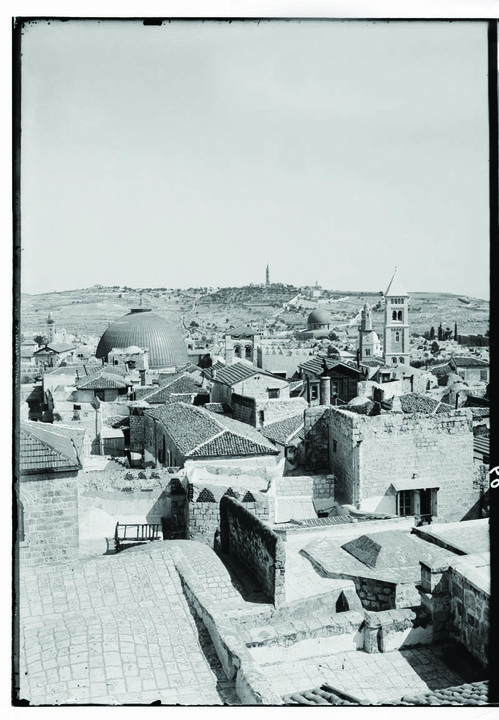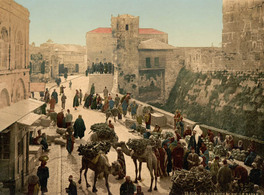Exhibitions
Index / Activities / Exhibitions / Jerusalem in Memory
Jerusalem in Memory
From May 04, 2015 until May 28, 2015Opening event on May 4 at 8:30 p.m. As of that time, the exhibition will remain open Mondays through Saturdays from 11:00 a.m. to 3:00 p.m. and from 4:00 to 7:30 p.m. Sundays, from 11:00 a.m. to 3:00 p.m.
MADRID
Casa Árabe exhibition halls (at Calle Alcalá, 62).
Opening event on May 4 at 8:30 p.m. As of that time, the exhibition will remain open Mondays through Saturdays from 11:00 a.m. to 3:00 p.m. and from 4:00 to 7:30 p.m. Sundays, from 11:00 a.m. to 3:00 p.m.
Free entrance until the event’s capacity is reached.
Photography from the collections of Sultan Abdulhamid II and the archives of the IRCICA.
Casa Árabe is hosting an exhibition of old photographs offered by the Center for Research on Islamic History, Art and Culture of Istanbul (IRCICA) with the cooperation of the Embassy of the Republic of Turkey in Madrid and the Diplomatic Mission of Palestine in Spain. The collection allows us to get a look at Jerusalem in the late nineteenth century and early twentieth century through photographs selected from the collection of Ottoman Sultan Abdulhamid II and the IRCICA’s archives at the Palace of Yıldız (Istanbul).
Throughout the thousands of years in its history, Jerusalem has been a crossroads for different civilizations and was successively governed by a series of different States. As a result of that unique history, Jerusalem became a Holy City for the three religions of the Book: Islam, Christianity and Judaism. The city’s structures, settlements, social life, sanctuaries, monuments and traditions bear witness to a multicultural heritage in which the beliefs of all the people who worship Jerusalem come together. The photographs, which date back to the late Ottoman period, also evoke the shared memory of a time of tolerance when the existence and heritage of each faith were respected and protected.
Due to its special importance, as soon as photography was developed as a technology, Jerusalem was visited by photographers from all over the world, including the Ottoman State. The Ottoman Court was amongst the first to acquire photographs of Jerusalem, and of Palestine in general. These photographs were included in the collection belonging to the Palace of Yıldız. The printed and digital copies of these photographs are preserved today in the IRCICA’s archives along with photographs from other collections.
The exhibition presented at Casa Árabe is complemented by a small selection of photographs of today’s Jerusalem, which were provided by the Diplomatic Mission of Palestine in Spain. They illustrate the continued existence of this historical legacy up to the modern day.
Throughout the thousands of years in its history, Jerusalem has been a crossroads for different civilizations and was successively governed by a series of different States. As a result of that unique history, Jerusalem became a Holy City for the three religions of the Book: Islam, Christianity and Judaism. The city’s structures, settlements, social life, sanctuaries, monuments and traditions bear witness to a multicultural heritage in which the beliefs of all the people who worship Jerusalem come together. The photographs, which date back to the late Ottoman period, also evoke the shared memory of a time of tolerance when the existence and heritage of each faith were respected and protected.
Due to its special importance, as soon as photography was developed as a technology, Jerusalem was visited by photographers from all over the world, including the Ottoman State. The Ottoman Court was amongst the first to acquire photographs of Jerusalem, and of Palestine in general. These photographs were included in the collection belonging to the Palace of Yıldız. The printed and digital copies of these photographs are preserved today in the IRCICA’s archives along with photographs from other collections.
The exhibition presented at Casa Árabe is complemented by a small selection of photographs of today’s Jerusalem, which were provided by the Diplomatic Mission of Palestine in Spain. They illustrate the continued existence of this historical legacy up to the modern day.
The Center for Research on Islamic History, Art and Culture of Istanbul
(IRCICA) is an intergovernmental institution made up of 57 Member
States, dependent upon the Organization for Islamic Cooperation.
It carries out tasks involving research, publication and documentation, and it organizes congresses, international projects and training programs in fields such as History, the Arts, Sciences and the preservation of architectural heritage. Through these activities, it contributes to strengthening the mutual understanding between the peoples of West and East. The library and archives services of the IRCICA include the publication of collections and catalogues of art, documents and photographs, as well as the organization of exhibitions around the world.
It carries out tasks involving research, publication and documentation, and it organizes congresses, international projects and training programs in fields such as History, the Arts, Sciences and the preservation of architectural heritage. Through these activities, it contributes to strengthening the mutual understanding between the peoples of West and East. The library and archives services of the IRCICA include the publication of collections and catalogues of art, documents and photographs, as well as the organization of exhibitions around the world.


